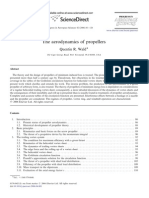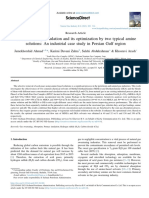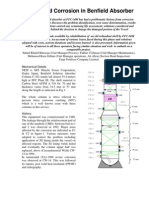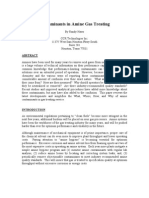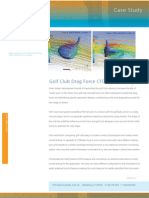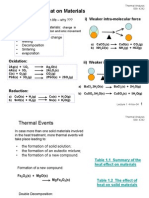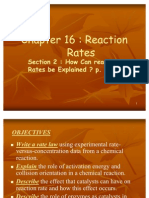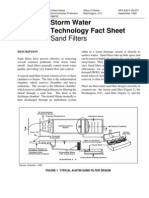Customized aMDEA Process For Acid Gas Removal
Customized aMDEA Process For Acid Gas Removal
Uploaded by
Arjun BabuCopyright:
Available Formats
Customized aMDEA Process For Acid Gas Removal
Customized aMDEA Process For Acid Gas Removal
Uploaded by
Arjun BabuOriginal Title
Copyright
Available Formats
Share this document
Did you find this document useful?
Is this content inappropriate?
Copyright:
Available Formats
Customized aMDEA Process For Acid Gas Removal
Customized aMDEA Process For Acid Gas Removal
Uploaded by
Arjun BabuCopyright:
Available Formats
Customized aMDEA Process for Acid
Gas Removal
The operational experience with aMDEA gas scrubbing units shows that they contribute substantially
to both the reliability and the economy of the ammonia plant.
R. Hugo, H. Meissner, and R. Welker
BASF AG, Ludwigshafen, Germany
Introduction Process History
T
he CO2 removal system represents a major The development of the aMDEA process was started
energy consumer in an ammonia plant. An in the late 1960s. The first aMDEA unit went on-
energy-efficient gas scrubbing process is thus stream in 1971 with the commissioning of the No. HI
sine qua non for economic production. On the other ammonia plant in Ludwigshafen, Germany. In the fol-
hand, the economics of the ammonia plant also require lowing years, eight more BASF plants were fitted with
high on-stream times. Each extra plant shutdown due aMDEA gas scrubbing units.
to a failure of the CO2 removal unit causes a consider- The operational experience with these aMDEA units
able loss of production and adversely affects plant provided the incentive to license the process from
safety. For these reasons, the selection of BASF's 1982 onward. To date, the aMDEA process has been
aMDEA process can make a substantial contribution operated successfully in a total of 66 reference plants
to both the reliability and the economy of the whole worldwide, with some 20 additional units currently
ammonia plant. being under design or construction.
Assuming that U.S. ammonia producers are already
well acquainted with aMDEA, this article will briefly Applications
recapitulate the applications and process features,
which will subsequently be illustrated by a detailed The aMDEA process is suitable for a wide range of
consideration of two examples of retrofitting existing applications (Figure 1). Besides removing CO2 from
CO2 removal units (with all the inherent system con- ammonia synthesis gas, aMDEA units can be used to
straints this task implies. purify CO/H2 synthesis gas, to sweeten natural gas,
AMMONIA TECHNICAL MANUAL 330 1997
and for speciality applications such as purification of • aMDEA types 04 thru 06 in a standard single-stage
blast furnace gases. unit, characterized by reduced investment costs and
40% of all aMDEA reference units are to be found very low CO2 slippage in the treated gas (Figure 6).
in ammonia plants; more than half of these were in The number of aMDEA solvent systems combined
turn originally operated with alternative solvents and with a variety of appropriate process configurations
converted to aMDEA to solve various operating prob- ensure a design tailor-made for a given application, be
lems encountered with the former solvents. it a revamp or a new plant.
Process Features Retrofit of Acid Gas Removal Units
The aMDEA solvent systems are aqueous solutions For the "grassroots" design of a new plant, the sol-
of the effectively nonvolatile methyldiethanolamine vent, the configuration, and the process parameters
plus a small amount of an activator to enhance the can be customized to meet all production and site
CO2 absorption rate (Figure 2). requirements. For a revamp, however, the design
Generic MDEA reacts with water and CO2 to yield needs considerable process flexibility to conform to a
the corresponding protonated species and bicarbonate given application. Many additional constraints result
(Figure 3). The overall rate of conversion is very low. from the equipment already installed and the integra-
The absorption can be accelerated by the fast reaction tion of the unit in the ammonia plant. The following
between CO2 and the activator, a secondary amine, examples illustrate such situations.
which together form a carbamate. The carbamate in The first example involves typical conditions for the
turn reacts with the bulk solvent (aqueous MDEA) U.S. reference plants, all of which entailed conver-
transferring its CO2 and thereby being regenerated for sions of ammonia synthesis gas scrubbing units to
further reaction. The activator therefore behaves in a aMDEA (Figure 7). The second example describes the
similar manner to a homogeneous liquid catalyst with revamp of a hot potassium plant in Australia.
no net consumption, but rather several reaction-regen-
eration cycles along the length of the absorber. Conversion from an amine-based solvent
The high loading capacity of MDEA results in low
The U.S. references are all ammonia plants with a
solvent circulation rates, while the activator keeps the
capacity in the range 650-1,500 mtpd, and all have a
absorber height to a minimum. The solvent regenera-
tion can be carried out to a large extent simply by background similar to that of the unit portrayed in the
flashing the aMDEA solution. following example. The gas scrubbing unit comprises
An extra degree of flexibility is achieved by varying a single-stage absorption and stripper regeneration
the activator concentration (Figure 4). This has the (see Figure 6) and was originally operated with
effect of tuning solvent behavior to either a more monoethanolamine (MEA).
This unit has been converted to another amine based
"chemical" or a more "physical" character. The highly
system in the context of a capacity increase. The alter-
activated MDEA 06 has more of a chemical solvent
nature, that is, good absorption efficiency but energy native of achieving a higher plant capacity by an
increase of the MEA concentration was ruled out by
intensive regeneration, while the weakly activated
the operational experience regarding the corrosivity of
MDEA 01 has only a moderate absorption efficiency
the MEA solution, especially at higher concentration.
but benefits from an energy efficient regeneration,
Understandably, the corrosivity of the solution was
similar to that for a physical solvent.
investigated extensively. Following the swap, solvent
Typical application criteria for CO2 removal from
analyses showed no untoward heavy metal content in
ammonia synthesis gas are:
the solution for the first year. Thereafter, some weight
• aMDEA types 02 thru 04 in a standard two-stage
loss was observed on the corrosion coupons and sub-
unit, characterized by low energy consumption values,
sequently a steep increase in the concentration of
high gas purities, and good recovery rates (Figure 5);
AMMONIA TECHNICAL MANUAL 331 1997
Figure 1. Application of BASF's aMDEA-process. Figure 2. Activated MDEA solvent system.
13as Uquid
Fast
•ff^'tM^
\ MDEA + H2O
£v ' Vj '
>A ; >. V „
( -^ ^ '»'"'
MDEAH* + HCO3-
Sfow, _:
»BVÎ J-Vï*
P;-^^
^,« C4KA^M*^ MDEA- ^*.~Äf.' >*"«• "• -n ^S-?*,«1 Vä^'^iXfeiij j> , £
Figure 3. Absorption mechanism. Figure 4. CO2-loadmg capacity of various solvents.
AMMONIA TECHNICAL MANUAL 332 1997
.., —
w^rrsfflKP^ * M"4v
_7V^r.jT^ïîtJ. i ^igsPf |^kiÄSÄ&
-«^^ <>*a^VlV .^fSÄ^ ', . «fc
"«•' • ~* ">: i v" «-j« :
-- t"
T • ' --;•>'
•-- .~f>
v 5tC^>s
-'.** jfj-v-^. T. -fl"*i- <-/,f«
"'?-, Jl *ftx" ; i'.^:f
iiii^sr."W,--.i~v--
water , V£yy. fA ^;
4
< i * * i ."i -.7- IÄ??"' -î's«f ? * V*»A-,wS
. *' %" " >*g%? —1 «'"' > .-VJ
Figure 5. Two-stage absorption. Figure 6. Single-stage absorption.
Figure 7. Plant locations. Figure 8. Damaged tubes from the four
exchangers.
AMMONIA TECHNICAL MANUAL 333 1997
heavy metals (Fe, Cr, Ni) in the solution took place. tubes from the four exchangers.
Corrosion problems occurred especially in the solvent The shell of the lean solution cooler (solvent on
heat exchangers (2 parallel stacks, each of 2 individual shellside) also exhibited wear-and-tear, probably as a
exchangers) and in the regenerator (duplicate parallel result of erosive corrosion.
tray columns) along with several additional shutdowns Special attention must be paid to the feed device of
and the need to replace corroded equipment. The
hopes placed in this second solvent thus proved to be Table 1. Heavy Metal Content of the aMDEA
unfounded, as the unit still suffered from leaks due to Solution
corrosion.
At this point, a straight solution swap to aMDEA Months of Cr Ni Fe
was carried out without any plant modifications. In a Operation (wppm) (wppm) (wppm)
rapid turnaround, the previous solvent was drained off,
the unit cleaned, filled with aMDEA solution and 7 7 1 7
restarted. 11 1 1 5
13 1 1 4
Equipment inspection after draining off the previ- 16 2 1 7
ous solvent 20 3 2 6
23 2 1 5
No Corrosion was detected in the absorber column. 1 4
26 5
The stripper columns showed corrosion in the bot-
29 4 6 6
tom sections and between the trays. The corrosion was
of a local nature, being characterized by cavities of 2 33 5 8 4
in. (5 cm) diameter and up to 2/5 in. (1 cm) depth from
a height of approximately 6.5 ft (2 m) up to the loca-
tion of the packing support grid. The material around the regenerator when converting a chemical solvent to
the cavities was friable and could easily be removed aMDEA: about 30-50% of the CO2 is released from
mechnically. The material within the manhole showed the rich solution by depressurization. The degassing
similar corrosion effects. therefore starts just downstream the pressure relief
The stripper reboiler heads were damaged with the valve and continues in the upper section of the regen-
pitting corrosion characteristic of hot CO2/water vapor erator. In a tray column flashing takes place on the top
attack. tray. The flashing solution, however, shall not enter
The four solvent heat exchangers are fitted with the downcomer, as degassing in the downcomer can
stainless (SS) tubing and carbon steel (CS) shells. result in flooding of the column. In case the regenera-
Although the expansion valve is located downstream tor is fitted with packing, the existing distributor must
the solvent heat exchangers, degassing of CO2 of the be adapted for the operation with a flashing feed. At
rich solution most probably occurs, which results in a any rate, the disengagement zone above the feed
two-phase flow through the exchangers, giving rise to device must be sufficiently high hi order to avoid solu-
severe corrosive attack: In the exchanger heads (pre- tion entrainment.
dominantly at the hot end) pitting corrosion was
observed over the entire CS material (about 2 mm Precleaning and repair work
depth) as well as at the welds (4 mm depth). Even
though the tubes were of SS, about 10% leaked. The system was cleaned section by section: first
Corrosion was confined to within the tubes, as the opening manholes and bottom drains of columns and
outer surface still appeared to be in good shape. The tanks, then removing orifice meters in the liquid lines
CS elements used to support the tube bundles were after closing off the taps hi impulse pressure line con-
extensively corroded. Figure 8 depicts the damaged nections beforehand and finally flushing the equip-
AMMONIA TECHNICAL MANUAL 334 1997
Figure 9. Corrosion rates in bottom of stripper. Figure 10. Revamp of hot-pot unit in Australia.
Non-corrosive solvent
J fff
i " "• •• i' ', " f/\ f Ie *•' ff
if " t J s' , '' f' ,'f-ff ,'"• f •*,.•• 4 ''fr If ff
^ ' vfJ* "V £<*• vl i'tf >' J<ff
^ f r if'r t X 's ' ± f f f
i . f
v . f r
v f ^ "" ^
:;,'. No toxic corrosion Inhibitors required
'• <:'. No passivation procedure required;' • '
^ f^ f^^ff ' " f ••'">•• * S S-, SS - ff f f * * / ' J f -,-,* , , - , * ,
;-, * Signlficantiy lower thermal energy consumption
-v'; No solid precipitation In the solution,
•> %
/-,; No special tracing requirements
. f* 'f * f '
>J' No environmental, problems'
•'' ï Minimum- analytical requirements-
,'-/,; Easy to operate/'very '*forglvlog*;;and; robust process'
11. aMDEA compared to hot potassium carbonate systems.
AMMONIA TECHNICAL MANUAL 335 1997
ment with water using firehoses and/or water jets. The The system was checked for leakages and put under
heat exchanger tube bundles were removed and nitrogen pressure. The aMDEA premix was introduced
cleaned with a high pressure water jet. Particularly the from tank containers into the system and diluted with
tubing in the solvent heat exchangers showed a firm water down to 45wt.% amine concentration. The sol-
deposit layer inside the tubes, which could neverthe- vent loop was closed, defoamer was added, and the
less be removed with a caustic solution jet. The outer circulating solvent was heated up to the design condi-
surface of these tubes was covered with a grayish- tions. The gas throughput was set to 75% of the design
brown layer (most probably FeCO3) after cleaning, capacity. Within 3 days, a capacity of 108% could be
which could also be removed easily. achieved and the conditions (energy, solvent, flow
The corroded equipment surfaces were washed off rate) had been optimized to meet the design CO2 slip
with a water jet. Corrosion cavities were then hollow- of 20 vppm.
grinded, polished and repaired with a corrosion protec-
tion layer (0.6-1 mm thickness) applied by a thermal Operating experience after the swap
metal spraying procedure. The bottom section of the
stripper columns was covered with metal dust from the The corrosion attack associated with the previous
spraying procedure, and the trays and the column base solvent is clearly indicated by a material loss from the
had to be cleaned with a vacuum cleaner. test coupons in the mm per year range (Figure 9).
After the revamp to aMDEA, the corrosion was com-
Cleaning procedure prior to startup pletely eliminated, without needing to add any corro-
sion inhibitor. In contrast to the previous solution, the
The two stripper columns were flooded with con- heavy metal content of the aMDEA solution (as tabu-
densate and then drained. This procedure was repeated lated in Table 1) was kept virtually constant in the low
once more with samples being taken to check for the ppm range.
absence of residual suspended particles in filtration Other amine-based systems (such as MEA, DEA,
tests. DIPA) have also been successfully converted to
Afterwards, the whole unit was filled with conden- aMDEA with considerable energy savings achieved
sate, heated up to 176-194°F (80-90°C) and circulated and a complete eradication of earlier corrosion prob-
for 4 h, with about 10% of the flow rate passing lems. The demands on the flexibility of the solvent,
through the mechanical filter. The condensate analysis however, are considerably higher if the solvent being
after 4 h circulation showed no foam activity or sus- replaced is of a completely different nature to an
pended particles, and the sample had a yellowish- amine solution, as in the following example.
brown coloration. The condensate circulation proce-
dure was repeated, with the sample showing no decol- Conversion of a hot potassium carbonate unit
oration as a result.
The cleaning efforts can be reduced or enhanced The second example deals with the very first revamp
depending on the very situation and the history of each of a hot-potassium carbonate unit to aMDEA. The 720
plant. In this case, for instance, the system was not mtpd ammonia plant in Australia comprised a two-
flushed by circulating caustic solution or dilute stage hot-pot gas scrubbing unit. Toxic arsenic salts
MDEA solution as usually recommended, especially were used both for activation and corrosion inhibition.
for the removal of grease or other residues such as cor- In recent years, sections of the pipework and packed
rosion inhibitors, rust, and so on. The caustic flushing beds had to be replaced owing to the corrosivity of
should, however, be employed when considerable con- the hot-pot solution.
struction work has been carried out, if new equipment The main problems, however, were escalating costs
has been installed or if the entire plant is new. for disposal of the arsenic-containing purge stream and
Startup the presence of arsenic in the plant wastewater.
The process configuration and the operating condi-
AMMONIA TECHNICAL MANUAL 336 1997
lions of this Australian hot-pot unit (Figure 10) are vent heat exchanger was installed to cool the lean
significantly different from a standard two-stage solution from the stripper bottom and the lean solution
aMDEA unit (see Figure 5): pump was operated at higher speeds. A peculiarity of
• No lean/semilean solvent heat exchanger. the solvent heat exchanger (in contrast to the
• Ratio semilean to lean solvent flow rate 4.5 vs. 6-7 lean/semilean solvent heat exchanger of the standard
for aMDEA. design (see Figure 5)) is the shellside flow of CO2-
• Lean solvent temperature of 169°F (76°C) vs. loaded rich solution and the tubeside flow of the lean
122°F (50°C) for aMDEA. solution. This arrangement was chosen in order to take
• Semilean solvent temperature of 234°F (112°C) vs. into account the high ratio of rich to lean solution in
167-185°F (75-85°C) for aMDEA. the operation of the existing unit. CO2 is thus released
by heating up the rich solution in the exchanger. A
lean solution air cooler instead of a solvent heat
Table 2. Three Consecutive Flushing Steps Using exchanger was not a practical alternative due to the
NaOH Solution higher space requirements, and an additional water
cooler was ruled out by the increased water consumption.
NaOH Circulation Max. Arsenic
• The duty of the existing lean solution cooler was
(wt.%) 00 (wppm) increased by providing cooling water at a lower tem-
perature. The lean solution temperature could be
4.0 8 1,900 reduced from 169°F (76°C) to 158°F (70°C) in this
3.9 8 160 way, thus giving rise to a higher solution loading
1.7 6 60 capacity and a reduced solvent flow rate. By this
means, the aMDEA design was rendered compatible
with the capacity limits of the existing pumps.
• Low pressure flash fitted with packing of about 3 • The hot-pot unit was operated at a process gas tem-
times the height as for aMDEA. perature of 433°F (223°C). As such conditions are
• Density of hot-pot solution approximately 25% beyond the operational experience of aMDEA refer-
higher compared to aMDEA. ence units, it was decided to install a process gas cool-
Generally, the main challenge for the solvent con- er upstream of the regenerator gas reboiler to reduce
version of hot-pot units arises from the considerably the absorber inlet gas temperature down to 329°F (165
lower temperature level in the absorber and the lower °C). A gas inlet temperature of 329°F is still adequate
aMDEA density. Both factors typically lead to bottle- to operate the regenerator properly since the energy
necks due to a lack of cooling capacity (most units do consumption is much less for aMDEA. The new heat
not even have a semilean solution cooler!) and inade- exchanger is part of a reformer feedstock saturator
quate capacity in the solvent pumps. scheme, thus providing energy recovery from the feed
gas.
Process modifications 9
The lean absorber section was fitted with
polypropylene packing, which was severely deformed.
For the above reasons, a straight solution swap (as The two PP packed beds have now been replaced by 1
described in the section on conversion from an amine- in. S.S. TP304 rings.
based solvent) is not usually feasible. The following • Parts of the piping showed corrosion and were
modifications had to be carried out for this Australian replaced by SS TP304 lines.
revamp assignment. « About 80% of the released CO2 was previously
• At full capacity, the suction pressure of the lean vented to the atmosphere at 194°F (90°C).
solution pump (when operated with aMDEA) would Only 20% of the CO2 was cooled down to 113°F (45
have fallen below the required limit. To provide suffi- °C) condensed and processed up to foodgrade quality.
cient head for the less dense aMDEA, a lean/rich sol- An additional CO2 cooler, reflux drum, and reflux
AMMONIA TECHNICAL MANUAL 337 1997
Table 3. Comparison of Operating Data for the Hot-Pot Solution
Hot-Pot Solution aMDEA Solution
Feed gas 185°F (85°C) 185°F
429 psia (29.6 bara) 429 psia
18 vol.% CO2 18 vol.% CO2
CO2 slip <500 vppm <500 vppm
Lean solution 169°F (76°C) 158°F(70°C)
Semilean solution 234°F(112°C) 180°F (82°C)
Absorber bottom 226°F (108°C) 203°F (95°C)
Process gas reboiler in operation in operation
Steam reboiler in operation not in use
Specific energy consumption 49.9 mbtu/lb mol CO2 32.7 mbtu/lb mol CO2
pump were installed parallel to the existing reflux cir- tified as very fine rust particles (probably iron/arsenic
cuit in order to provide a moderate temperature of the complex) in the size range 5-50 urn; the foam test with
CO2 off-gas stream, thus limiting the vapor phase sol- aMDEA indicated a significant foaming tendency.
vent losses. • A further water flushing step was not carried out in
order to limit the amount of arsenic contaminated
Cleaning of the Unit flushing water. It was decided to allow for the higher
foaming tendency by running the mechanical filter (5-
The unit had been operated with a hot-pot solution 10 u,m cartridges) at its maximum throughput from the
since 1969 using arsenic salts as corrosion inhibitor very beginning of the solvent circulation and employ-
and activator. It was therefore to be expected that con- ing an appropriate defoamer dosage rate.
siderable amounts of precipitated corrosion products
(deposit of iron/arsenic complex) were deposited on Startup
equipment surfaces. There were some concerns
regarding the fact that aMDEA is known to dissolve The unit was filled with aMDEA premix and the
such deposits quite well, which might have increased water content and column levels adjusted by adding
foaming susceptibility and carryover of the solution condensate.
from the regenerator into the condensate reboiler. The solvent circulation was commenced at about
The cleaning procedure was carried out as follows: 50% of the design flow rate. After 12 h of circulation,
« Three consecutive flushing steps using NaOH the solution had a reddish-brown color and a foam test
solution at 194°F (90°C), each of which was broken indicated formation of very stable foam (collapse time
off after the arsenic content had attained its maximum more than 5 min). After filtering the aMDEA sample,
are shown in Table 2. the color turned light yellow and the foam activity was
• Two consecutive water flushing steps were at reduced to the normal values.
194°F (90°C); the water analysis after the second An extra dose of defoamer was introduced into the
flushing step gave 60 wppm iron, 7 wppm arsenic, 80 solution loop and the circulation rate increased to 95%
wppm NaOH and 100 wppm solids and the sample of the design figure: the column levels became unsta-
exhibited a dark brownish color. The solids were iden- ble and hence a further shot of defoamer was added.
AMMONIA TECHNICAL MANUAL 338 1997
The column levels remained constant and the next BASF operates two ammonia plants in
foam test showed no significant foaming tendency. Ludwigshafen, Germany: Both plants No. HI and No.
The solution circuit was heated up to the design val- IV, a 1,350 mtpd unit, which have come on-stream in
ues with the regenerator steam. The CO2 cooler and 1971 and 1982, respectively, are equipped with low-
reflux pumps were put into operation. The semilean energy two-stage aMDEA systems (see Figure 5).
and lean solvent temperatures to the absorber were Following a capacity increase some years ago, the
adjusted at a later stage when the solvent coolers were gas scrubbing unit of the No. IV plant was being oper-
started up. ated at the limits of the certain existing equipment
Process gas was fed through the plant at 50% capac- items such as solution pumps and columns. A second
ity. Within 12 h, the plant throughput was increased to plant expansion of 6% was recently carried out with-
80% of the design figure. Process conditions were out any equipment changes or capital costs being
then optimized at full capacity. involved.
Although the process conditions of a hot-pot system The activator content in the solution was increased
differ significantly from aMDEA units, the aMDEA slightly, thus leading to a higher absorber efficiency by
design for this unit showed a good compatibility with shifting to more chemical solvent characteristics. As
the existing equipment. A comparison of the operating the activator could be added during operation, no shut-
data for the hot-pot solution and the aMDEA design down was necessary.
for 100% capacity is tabulated in Table 3.
A summary of the benefits from the 1994 solvent Conclusion
conversion is given in Figure 11:
• The aMDEA solvent does not require the addition This article deals with a specific range of aMDEA
of any corrosion inhibitor. Hence, the costly disposal applications, namely the conversion of solvents in
of toxic arsenic-material (inherent for the hot-pot sys- existing ammonia plant gas scrubbing units.
tem) is completely avoided. Even the time-consuming Units which are designed to be operated with amine
passivation of the equipment prior to a startup of the based solvents can most often be converted to aMDEA
hot-pot system can be omitted, thus keeping the turn- in a straight solution swap: the old solvent is drained
around periods to a minimum. off, the system is cleaned, filled with aMDEA premix,
• Although the process conditions are not cus- made up with condensate, started up (faute de mieux
tomized for the aMDEA solvent system, the energy with the old conditions), and optimized.
saving is still 35% compared with the hot-pot opera- The conversion of units designed for solvents with a
tion. totally different nature to amine solutions normally
• The operator workload is lightened as the intense requires some equipment changes, however. Hot
supervision required for operation of the hot-pot unit potassium revamps, for instance, are characterized by
is no longer necessary. Precipitation does not occur a lack of adequate cooling and pump capacities.
with aMDEA; thus, heat tracing is not required. The Furthermore, the heat integration of the gas scrub-
revamped unit is operated with virtually no liquid bing unit within the whole ammonia complex can
purge stream, as there is no need to separate decompo- exert constraints determining the operating conditions
sition products or to purge the solution thereof. The at certain locations in the unit, such as boiler feedwa-
plant monitoring has been reduced to a minimum, with ter heaters (T, dT, heat duties, and so on). This can
only a few simple analyses remaining to be carried turn out to be a bottleneck, for instance, due to differ-
out. ent physical and thermal properties of the solvents.
The flexibility of the aMDEA process takes account of
Operational Experience such constraints by allowing one to change the funda-
mental nature of the solvent. Even if such a revamped
The flexibility of the aMDEA process also offers unit cannot be operated at the optimum conditions
attractive operational features. when compared to new, grassroots aMDEA units,
AMMONIA TECHNICAL MANUAL 339 1997
advantages still accrue, that is, no corrosion, energy three illuminating examples of the economic efficiency
efficiency, and no purge stream disposal. and reliability of the aMDEA process, which is further
The straight solution swap in the U.S., the revamp of characterized by the cardinal virtues of being environ-
the hot-pot unit in Australia, and the capacity increase mentally friendly, easy-to-operate, and very forgiving,
of BASF's ammonia plant in Ludwigshafen provide
AMMONIA TECHNICAL MANUAL 340 1997
You might also like
- BASF R0-20 Data SheetDocument1 pageBASF R0-20 Data SheetAmir RahbariNo ratings yet
- Activated Alumina F220 Data SheetDocument2 pagesActivated Alumina F220 Data SheetRawlinson100% (1)
- CMG GemDocument2 pagesCMG Gemhsalmani69No ratings yet
- The Aerodynamics of PropellersDocument44 pagesThe Aerodynamics of PropellersShmuel Yonatan HayounNo ratings yet
- Gas Sweetening Simulation and Its Optimization by Two Typical AmineDocument8 pagesGas Sweetening Simulation and Its Optimization by Two Typical AmineYogesh PatilNo ratings yet
- Haldor Topsoe AmmoniaDocument16 pagesHaldor Topsoe Ammoniatatoo1No ratings yet
- BASF R5-12 Data SheetDocument1 pageBASF R5-12 Data SheetAmir RahbariNo ratings yet
- Methyldiethanolamine As A Solvent For Gas DesulfurizationDocument66 pagesMethyldiethanolamine As A Solvent For Gas DesulfurizationAnime MtNo ratings yet
- Solutions For The Treatment of Sour GasDocument14 pagesSolutions For The Treatment of Sour GasJuan Miguel Mendoza OlanNo ratings yet
- Degradation Studies of AminesDocument14 pagesDegradation Studies of Aminessnikraftar1406No ratings yet
- Ammonia: A Company of Thyssenkrupp TechnologiesDocument28 pagesAmmonia: A Company of Thyssenkrupp Technologiesenghisham100% (1)
- Ethanolamines: Product InformationDocument48 pagesEthanolamines: Product InformationElias0% (1)
- Daily Status SheetDocument72 pagesDaily Status SheetMohammad FarhanNo ratings yet
- Recovered Hydrogen As Quench in CO Conversion Section: P. Ravichandran, Hussain A. Al-Hajari, and Yousif A. Al-NassarDocument8 pagesRecovered Hydrogen As Quench in CO Conversion Section: P. Ravichandran, Hussain A. Al-Hajari, and Yousif A. Al-Nassarvaratharajan g rNo ratings yet
- In Amenas TrainingDocument116 pagesIn Amenas TraininghichamNo ratings yet
- Air Liquide 2022 Article On Off Gas Use in SMRDocument5 pagesAir Liquide 2022 Article On Off Gas Use in SMRKokil JainNo ratings yet
- BASF Operating Handbook Rev June 2008Document26 pagesBASF Operating Handbook Rev June 2008liuzhy007No ratings yet
- Questions and Answers For Primary ReformerDocument3 pagesQuestions and Answers For Primary ReformerMaged HegabNo ratings yet
- 4 004 Potassium Carbonate Carryover PDFDocument25 pages4 004 Potassium Carbonate Carryover PDFZen AlkaffNo ratings yet
- Basf AdsorbentsDocument8 pagesBasf AdsorbentsNasir KhanNo ratings yet
- Catschool 1: Prereforming CatalystsDocument32 pagesCatschool 1: Prereforming CatalystsAbubakar Siddiq100% (1)
- SC General Catalogue 2007 (3MB)Document146 pagesSC General Catalogue 2007 (3MB)yeknom100% (1)
- BF-9201 US F-200 DatasheetDocument3 pagesBF-9201 US F-200 DatasheetNguyễn Kim HùngNo ratings yet
- Economic Evaluation of NGL Recovery Process Schemes For Lean Feed CompositionsDocument10 pagesEconomic Evaluation of NGL Recovery Process Schemes For Lean Feed CompositionsFranco Camacho CanchariNo ratings yet
- Mathenation CatalystDocument16 pagesMathenation CatalystMuhammad JunaidNo ratings yet
- International Journal of Greenhouse Gas Control: Sukanta Kumar Dash, Syamalendu S. BandyopadhyayDocument11 pagesInternational Journal of Greenhouse Gas Control: Sukanta Kumar Dash, Syamalendu S. BandyopadhyayYogesh PatilNo ratings yet
- Jefftreat MPDocument2 pagesJefftreat MPM TáłHà FâróòqNo ratings yet
- Systimization and Circuitization Creation Case StudyDocument12 pagesSystimization and Circuitization Creation Case Studyahmed sobhyNo ratings yet
- SelexolDocument2 pagesSelexolandrez627No ratings yet
- Accelerated Corrosion in Benfield AbsorberDocument12 pagesAccelerated Corrosion in Benfield Absorberalimirpur100% (3)
- Haldor Topsoe Ammonia Part2Document4 pagesHaldor Topsoe Ammonia Part2tatoo1No ratings yet
- New KBR Process For Coal To Ammonia: Kamal Gursahani, Siva Ariyapadi, Meghji Shah and Richard StraitDocument12 pagesNew KBR Process For Coal To Ammonia: Kamal Gursahani, Siva Ariyapadi, Meghji Shah and Richard Straitvaratharajan g rNo ratings yet
- Brochure Kboost V1 1sep2022Document5 pagesBrochure Kboost V1 1sep2022parsiti unnes100% (1)
- Amine Expert CompanyDocument2 pagesAmine Expert CompanyWajid NizamiNo ratings yet
- GV Absorber Shell Leak in Ammonia Plant-II at IFFCO, Aonla Unit, IndiaDocument12 pagesGV Absorber Shell Leak in Ammonia Plant-II at IFFCO, Aonla Unit, Indiavaratharajan g rNo ratings yet
- Automated Operation of Topsoe Steam Reformers LTMDocument8 pagesAutomated Operation of Topsoe Steam Reformers LTMrajuNo ratings yet
- 24 Axens Julie Maillot PDFDocument17 pages24 Axens Julie Maillot PDFEriko100% (1)
- Comtaminents in Amine Gas Treating UnitDocument13 pagesComtaminents in Amine Gas Treating Unitarvindgupta_2005No ratings yet
- How To Bring Existing Ammonia Plants Up-to-Date: Svend Erik NielsenDocument9 pagesHow To Bring Existing Ammonia Plants Up-to-Date: Svend Erik NielsenAlfonso BlancoNo ratings yet
- Hectatone B91 - ProductBulletinDocument1 pageHectatone B91 - ProductBulletinFederico ArqueroNo ratings yet
- Tail Gas Treating CatalystsDocument4 pagesTail Gas Treating CatalystsAhmed SaidNo ratings yet
- Haldor Topsoe Ammonia Part1Document4 pagesHaldor Topsoe Ammonia Part1tatoo1No ratings yet
- IPTC 10735 Process Optimization in Gas Sweetening Unit-A Case StudyDocument7 pagesIPTC 10735 Process Optimization in Gas Sweetening Unit-A Case StudyGary Kiel Palacios EspinozaNo ratings yet
- 263 269 JMTR Oct16Document7 pages263 269 JMTR Oct16Taniadi SuriaNo ratings yet
- JM Catalysts For Olefin ProcessesDocument16 pagesJM Catalysts For Olefin ProcessesAstridNo ratings yet
- Energy Conversion and Management: Haris Ishaq, Curran CrawfordDocument20 pagesEnergy Conversion and Management: Haris Ishaq, Curran CrawfordMd ArshNo ratings yet
- Haldor Topsoe Ammonia Part4Document4 pagesHaldor Topsoe Ammonia Part4tatoo1No ratings yet
- Concon AdsorbentReportDocument11 pagesConcon AdsorbentReportliuzhy007No ratings yet
- Gazchem 2007 Trinidad Integration of Urea and Melamine Plants Casale ExperienceDocument16 pagesGazchem 2007 Trinidad Integration of Urea and Melamine Plants Casale ExperiencerioRNo ratings yet
- Viscosities of Pure and Aqueous Solutions of Monoethanolamine (MEA), Diethanolamine (DEA) and N-Methyldiethanolamine (MDEA)Document8 pagesViscosities of Pure and Aqueous Solutions of Monoethanolamine (MEA), Diethanolamine (DEA) and N-Methyldiethanolamine (MDEA)Shahid HussainNo ratings yet
- Hydrogen Sulfide (H S) Production Technology: The Worldwide Market For H2S Continues To Grow at An Impressive RateDocument4 pagesHydrogen Sulfide (H S) Production Technology: The Worldwide Market For H2S Continues To Grow at An Impressive Rateingegnere1234100% (1)
- P Psa S G E P: Olybed Ystems FOR AS Xtraction and UrificationDocument2 pagesP Psa S G E P: Olybed Ystems FOR AS Xtraction and UrificationVivi OktaviantiNo ratings yet
- Large-Scale Ammonia Receiving Terminal For Power GenerationDocument3 pagesLarge-Scale Ammonia Receiving Terminal For Power GenerationsnamprogNo ratings yet
- Catalytic Reforming Options and PracticesDocument5 pagesCatalytic Reforming Options and PracticesanshumanNo ratings yet
- Linear Alkylbenzene 6035 1 HighDocument1 pageLinear Alkylbenzene 6035 1 HighSavan JaviaNo ratings yet
- Data Regression Analysis in Aspen Plus For CO2 Absorption Process Using MEA Final 3Document15 pagesData Regression Analysis in Aspen Plus For CO2 Absorption Process Using MEA Final 3Piyush Priyadarshi0% (1)
- HR 506Document1 pageHR 506mohsen ranjbarNo ratings yet
- BASF R5-12 Loading ProcedureDocument3 pagesBASF R5-12 Loading ProcedureNGUYỄN HOÀNG LINHNo ratings yet
- Simulation of Loading Capacity of MDEA and DEA For Amine-Based CO Removal Using HysysDocument6 pagesSimulation of Loading Capacity of MDEA and DEA For Amine-Based CO Removal Using HysysZack AmerNo ratings yet
- 2 2 2 Raphael Idem, Malcolm Wilson, Paitoon Tontiwachwuthikul, Amit Chakma, Amornvadee Veawab, Adisorn Aroonwilas, and Don GelowitzDocument7 pages2 2 2 Raphael Idem, Malcolm Wilson, Paitoon Tontiwachwuthikul, Amit Chakma, Amornvadee Veawab, Adisorn Aroonwilas, and Don GelowitznakurawNo ratings yet
- The Use of MDEA and Mixtures of Amines For Bulk CO2 RemovalDocument9 pagesThe Use of MDEA and Mixtures of Amines For Bulk CO2 RemovalTrùm Dầu Mỏ BkNo ratings yet
- Co 2 RevspDocument7 pagesCo 2 RevspNeima DoualehNo ratings yet
- Case Study: Golf Club Drag Force CFD AnalysisDocument2 pagesCase Study: Golf Club Drag Force CFD AnalysisAmoo MehrdadNo ratings yet
- Apuntes Filtración Con MembranasDocument21 pagesApuntes Filtración Con MembranasCarlos MedinaNo ratings yet
- Important Instructions To Examiners:: Sub. Code: 22401Document22 pagesImportant Instructions To Examiners:: Sub. Code: 22401Parth Magar100% (1)
- Stormwater Drainage System Design Worksheet: Page 1 of 5Document5 pagesStormwater Drainage System Design Worksheet: Page 1 of 5khoohuikiangNo ratings yet
- JT3D (TF33) S2P4Document128 pagesJT3D (TF33) S2P4junmech-1No ratings yet
- Type 310A-32A Pressure Reducing Regulator and Type 310A-32A-32A Working Monitor RegulatorDocument20 pagesType 310A-32A Pressure Reducing Regulator and Type 310A-32A-32A Working Monitor RegulatoramcodocontNo ratings yet
- HAZOP Case Studies For Workshop SessionDocument4 pagesHAZOP Case Studies For Workshop Sessionsaadiis100% (2)
- Heat Requirement CalculationsDocument5 pagesHeat Requirement CalculationsTrishul Nath PallayNo ratings yet
- Instrumentation LabDocument3 pagesInstrumentation LabPradyumna Somashekar MysoreNo ratings yet
- Lecture 1backupDocument16 pagesLecture 1backupZUL KAMARUDDINNo ratings yet
- Lecture 03 Performance in Straight Level FlightDocument14 pagesLecture 03 Performance in Straight Level FlightVÕ PHAN ĐỨCNo ratings yet
- RE 10 030/04.99 External Gear Pumps Type G: 2, Series 4XDocument12 pagesRE 10 030/04.99 External Gear Pumps Type G: 2, Series 4XEnayat IzadiNo ratings yet
- On-Line Analyzer Systems For Safety and Control of EDC Production PlantsDocument1 pageOn-Line Analyzer Systems For Safety and Control of EDC Production Plantslaoying qdNo ratings yet
- Ows Piping Size2BLDocument3 pagesOws Piping Size2BLArindomNo ratings yet
- Modelling and Simulation of Absorption Solar Air Conditioning SystemDocument20 pagesModelling and Simulation of Absorption Solar Air Conditioning SystemShadi KarkabaNo ratings yet
- Submersible Pumps: CN/CNH - CNLDocument8 pagesSubmersible Pumps: CN/CNH - CNLThanh PhuNo ratings yet
- Third Year Automobile Engineering: Term - I Heat Transfer Course ObjectivesDocument1 pageThird Year Automobile Engineering: Term - I Heat Transfer Course ObjectivesnkpatilNo ratings yet
- PRV, SavDocument15 pagesPRV, Savnoklit15No ratings yet
- 3-00 Hydraulic PrinciplesDocument59 pages3-00 Hydraulic Principleskdsessions100% (1)
- Chapter 16.Ppt Sec.2Document43 pagesChapter 16.Ppt Sec.2فارس بوعبيدهNo ratings yet
- Lectures - Mass TransferDocument34 pagesLectures - Mass TransferaaaNo ratings yet
- Pressure in Flowing FluidsDocument10 pagesPressure in Flowing FluidsIan SorzNo ratings yet
- Flow Visualization inDocument2 pagesFlow Visualization inVeeramani ShankarNo ratings yet
- Transfer Pump Set Head Loss Calculation - Basement 3rd PDFDocument2 pagesTransfer Pump Set Head Loss Calculation - Basement 3rd PDFMUBASHIRNo ratings yet
- 7 - Dr. M. Atia - Solved Examples Ch. 4Document22 pages7 - Dr. M. Atia - Solved Examples Ch. 4Bahaa RaghebNo ratings yet
- FireDocument10 pagesFireSia JoseNo ratings yet
- Tutorial Sol CH 20Document6 pagesTutorial Sol CH 20Abraham wisdomNo ratings yet
- Storm Water Technology - Sand FiltersDocument7 pagesStorm Water Technology - Sand FiltersGreen Action Sustainable Technology GroupNo ratings yet



